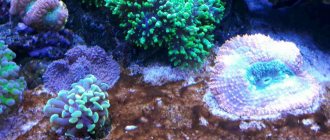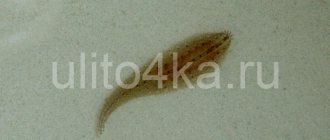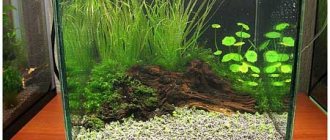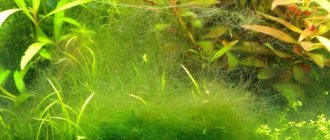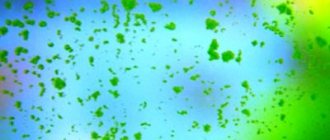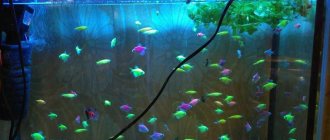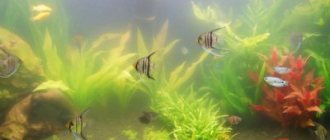An aquarium is a separate world that requires regular care. You cannot set up an aquarium and forget about it and its inhabitants. It needs to be cleaned, washed, the condition of the inhabitants and vegetation checked so that it remains beautiful and the inhabitants are healthy. Not all plants are equally useful. There are plants that seek to destroy all living things in it. These aquatic plants include filamentous algae. When filament appears in an aquarium, you need to know how to fight it, what to do to slow down the growth and spread of destructive vegetation.
What is filament
Filamentum grows well in hard water. You have already seen the influence of green filamentous ones: just remember what any swamp or artificial reservoir looks like that no one cares for. On top they are covered with a green layer of grass, similar to strands of hair. These are filamentous algae.
If filamentous green algae gets into the aquarium, they entangle stones, vegetation, and decor, growing rapidly. There is no room left for fish and other vegetation. As the plant grows, it releases harmful waste into the water, which pollutes the reservoir. The fish get entangled in thin green threads, food remains there and the fry are lost. The aquarium rots, which leads to the death of the entire ecosystem and biological life. Getting rid of threads will take a lot of time and effort.
Diatoms (diatoms)
Diatoms are among the most common organisms on Earth. In the aquarium, they appear as a brown coating, usually appearing within a week or so after the aquarium completes its cycle. Diatoms feed on the silicates available in your aquarium and disappear over time. Likewise, since they feed on silicates, every time you add more sand, rocks, or anything plastic, they can show up again. (Diatoms, of course, do not feed on silicates, but, like other algae, on nitrate, phosphate, etc., and they only need silicate to build a shell)
Methods of struggle.
Manual Removal: Diatoms can be easily removed from glass using a floating magnetic scraper; Using a syringe or a toothbrush, you can reach other areas of the aquarium. Be prepared that they can appear again quite quickly; they spread quickly and are able to move to new areas.
Cleaners: Cerithiidae and Neritidae snails and chitons are quite effective at removing diatoms, just like the types of algae that usually take the place of diatoms as the silicates in your system are depleted.
Reasons for appearance
The filament in the aquarium grows quickly: a week is enough for the aquarium to be completely covered with thick algae-type threads. Additional factors contribute to growth:
- bright light: if the tank with fish is exposed to sunlight or artificial lighting is used for more than 8 hours a day, the likelihood of developing threadworm increases;
- lack of oxygen;
- lack of plants: if there are few plants in the container, green filamentous ones have a better chance of growing quickly, since the plants feed on microorganisms in the water;
- contaminated aquarium: microorganisms, pollution, remains of decomposed food contribute to the growth of the plant in a short time.
Filamentous algae often appear in a new aquarium when the main plants have not yet taken root. An excess of microelements leads to their increased growth. Filamentous algae can be inadvertently brought in with other plants from a pet store.
Filamentum reproduces well if there is an excess of phosphorus and nitrogen in the water.
Places of growth and external features
The plant feels good in water with increased hardness. Compared to other aquatic plants, filament has a salty taste. In some ways it resembles swamp mud. Such algae live in bodies of water with weak currents or standing water.
There are several signs by which you can determine whether a plant is a filamentous algae:
Green algae grow due to substances present in water. It also fuels their process of photosynthesis, which occurs in the light.
The danger of thread
Filamentous algae consists of long and short thin plant threads that entangle everything in the water. Green filamentous ones can be formed into separate bunches, attached to the decor, cling to other plants, a filter, or lighting equipment.
A small amount of filamentous algae is acceptable in an aquarium. The appearance of filament in the aquarium indicates a favorable environment for planting other vegetation.
As they grow, filamentous algae harm its inhabitants:
- the toxins released by the thread negatively affect all residents, poisoning them;
- the death of the plant leads to natural decomposition of the plant, which leads to excess toxins in the water;
- algae grow, filling the entire space, preventing the growth of other vegetation, and occupying free space;
- fish can become entangled in algae and die;
- food accumulates in green filamentous fish, the water quickly becomes polluted, and the biological environment for the normal existence of fish is disrupted.
It is necessary to combat filamentous algae. Harmful algae can destroy the entire ecosystem, including fish.
Types of filamentous algae
Edogonium (Oedogonium)
Starts out as a light green fuzz on the edges of plants. Growing extremely quickly. When neglected, it envelops the entire plant, quickly depleting it. Appears due to a sharp imbalance in nitrates (NO3) and phosphates (PO4). Often occurs in fresh aquariums, when higher plants have not yet had time to stabilize, or in heavily planted aquariums with a small number of fish, where there is a lack of nitrates or, conversely, overcrowding leads to a bias in favor of nitrates. Contrary to popular belief, edogonium is poorly eaten by shrimp and fish. The right choice would be to remove the affected parts of the plants, equalize the nitrate/phosphate proportions, and increase the frequency and volume of substitutions in case of high nitrate readings. If CO2 is supplied, then pay attention that there are no surges in the saturation of water with carbon dioxide. It is worth analyzing the lighting - too intense lighting can weaken the plant's consumption of nutrients, which will lead to an increase in the position of algae. When the balance is restored and the plants are strengthened (adaptation, rooting), the edogonium weakens and disappears.
- Edogonium filamentous algae
- Filament under a microscope
Fight with hydrogen peroxide
Stabilizing the aquarium is the most correct way. But sometimes it is necessary to resort to the help of reagents. Hydrogen peroxide is used in proportions of 20 ml per 100 liters of aquarium, once at night in the dark. The average course of treatment is up to 5 days. With a normal NO3 balance, replacements are reduced and resumed only at the end of the course.
Fighting with sidex
Everything is the same as hydrogen peroxide, only the dosage is 10 ml per 100 liters of aquarium.
Attention! Sidex binds oxygen in the aquarium, so intensive aeration is necessary!
Spirogyra
This is the same algae that we used to call mud. Thin numerous threads form a dense colony, a rather disgusting, slimy mass to the touch. The emergence of this algae, like Oedogonium, is caused by sharp imbalances in nitrogen in one direction or another. Algae are able to consume nitrogen from various compounds, unlike higher algae, and any outbreak of NH3 (ammonia) or NH4+ (ammonium) can provoke a sharp growth of filament. Such an outbreak can be caused by severe siltation of the soil, stopping for a long time and then starting an external filter (the colony in the filter will die and the filter will become a source of infection), overfeeding of fish or mass loss of population. But a lack of nitrogen will lead to the same consequences.
- Aquarium heavily affected by Spirogyra
- Spirogyra under a microscope
- Spirogyra under a microscope
Fight with hydrogen peroxide
Again, our usual 3% hydrogen peroxide - 20 ml per 100 liters of aquarium, once at night in the dark. The average course of treatment is up to 10 days. Daylight hours in the aquarium should be significantly reduced. With a normal NO3 balance, replacements are reduced and resumed only at the end of the course. Do not forget about intensive aeration during treatment.
Cladophora
Another type of filamentous algae. A characteristic feature of this algae is its branching and rather rigid structure. As a rule, it has one attachment point for the whole bundle. It quickly takes up space at the bottom, especially where there is a stagnation zone. Not to be confused with the algae Cladophora globulus, which is often used by aquarists, although the latter is often a source of infection. It feeds like most higher plants, actively consuming CO2 and micro/macro elements. Loves light.
From the experience of aquarists from the forum:
- Fight against darkening, incl. with an increase/decrease in temperature - it’s useless, I hope this information will save someone’s nerves and time;
- Fighting “nutrition deprivation” is useless;
- You can kill it with copper-containing preparations, with a negative effect on plants and, in particular, shrimp.
- The use of peroxide has a negative effect on cladophora, but there is no exact recipe (at least I haven’t found one); The cell wall of the algae, unlike Spirogyra (“threads”), is 3-layered (chitin, pectose, cellulose), probably due to this it needs a 25 times larger dose of CuSO4 to die than Spirogyra.
Taking into account the high duration of death of cladophora in unfavorable conditions found in the sources, the following hypotheses are substantiated:
- Adding peroxide in a high dosage of 40-50ml/100l for at least 10 days (In particular, the Cladophora fast. How to get rid of it? [10]). I did not test this hypothesis, because the indicated dosage exceeds the safe one (according to the Internet 25ml/100l) for fish and plants.
- The application of peroxide is not critical doses, but for a long time - 20+ days. This hypothesis was tested in April-May 2015 as follows: I applied it locally at a dosage of 25 ml/100 l (the filter was turned off), then I turned on the filter. Cladophora was strongly suppressed, but did not die and grew back quite quickly.
- Simultaneously raising the temperature to 31-32C with the addition of peroxide can be most effective. I did not test this hypothesis, because There are shrimp in the aquarium, so I initially test hypothesis 2).
- Perhaps there is a way to combat it with zinc (0.4 mg/l). However, I don't know how damaging high doses will be to plants.
- Disinfection of plants can be effective (On the other hand, with what substance is an open question);
- Ultraviolet will help accelerate the final death.
points 5 and 6 - due to the fact that the algae does not form cysts.
Filament in the aquarium: how to fight
When green filamentous particles appear, you need to check the operation of the filter element and lighting equipment. Cold light favors the spread and growth of algae, so the light should be changed to soft.
When ammonia accumulates, the filament begins to grow rapidly. To reduce ammonia emissions, you need to regularly wash the filter, buy an additional plant, and reduce the number of fish in a small tank.
It is recommended to buy floating and fast growing algae. They take away the nutrition of green filamentous insects, causing them to die off.
It is worth checking the iron content in the water. The permissible amount of iron is 0.2 mg/l.
How to deal with filament in an aquarium with abundant growth? The only method of control is complete removal from the water. You need to completely rinse the container, all the decor, plants, and soil to remove all the threads. It is recommended to remove the light for two to three days.
If household control methods do not help, you can use algaecides or hydrogen peroxide. Pet stores sell special products containing glutaraldehyde; before use, you must read the instructions and act in accordance with the instructions. Hydrogen peroxide is added in an amount of 6-10 mg per liter of water.
If you are struggling with filament, buy fish that feed on these plants: catfish, gastromyzons, platies, mollies, carp, epalceorhynchos.
Natural enemies
Pros:
- Controlling algae using natural pests is a safe and gentle way.
Minuses:
- shrimp and fish that eat filament require special housing conditions and may not get along with the existing inhabitants of the aquarium.
Filamentous algae is a soft algae, so it is happily eaten by Amano shrimp, barbs, and neretina snails. It will be difficult for them to cope with a large-scale algae infestation, but they will destroy a small amount of the parasite quickly and with great appetite.
Barbs
These brightly colored fish must be kept in schools - at least 6 pieces in an aquarium with a volume of at least 60 liters. The water must be clean (a filter and compressor are required), the temperature must be 20-25 degrees. Barbs get along well with most fish, except for large predators and specimens with veil fins.
In the first case, they can become a victim, in the second, they can bite the fins of their neighbors. For the same reason, you should not allow barbs into an aquarium where there are plants with small, delicate leaves.
Amano shrimp
They owe their popularity to the most famous aquascaper Takashi Amano. Shrimp are kept in groups of 10 or more, and to combat threadworms it is better to choose large specimens. If the content of nitrogenous compounds in the water is high, they may die, so care should be taken about filtration and aeration. Amano get along well with any neighbors, with the exception of too large fish and predators that can feast on shrimp.
Neretina
Unpretentious snails with a beautiful yellowish-black shell. Neretinas love spacious containers with good filtration, aeration and moderate hardness. They feed on algae and organic debris, and rarely require additional nutrition.
Do not forget about the important feature of the natural enemies of filament. Well-fed fish, shrimp and snails will not eat algae, so they are not fed for several days before being introduced into the aquarium. After the parasite is destroyed, barbs, Amano shrimp and neretins can be kept to prevent the proliferation of filamentous shrimp. They do not require serious care and diversify the fauna of the aquarium well.
Coil snails are considered the most effective helpers in the fight against algae, but they often die immediately after being introduced into the aquarium. This is due to the fact that neretins do not tolerate sudden changes in water parameters. You need to launch the snails carefully, with the mouth down, as it is difficult for them to turn over on their own.
Prevention
If you take preventive measures in a timely manner and monitor the balance, you can avoid the appearance of threads. Preventive measures:
- regular cleaning of the aquarium;
- regular water changes;
- suitable light: lighting should be turned off every day for 10-12 hours;
- preventing direct sunlight;
- planting other vegetation;
- installation of the filter and its regular cleaning.
Vegetation is necessary to maintain the natural balance of the environment, favorable for fish, but it should not be allowed to grow abundantly. It is necessary to regularly inspect and clean the aquarium and remove excess food. When filamentous algae appears, follow simple recommendations to prevent their spread, then no problems will appear in the aquarium.
Dinoflagellates
These light brown, slime-like algae with trapped air bubbles appear to grow on rocks and sand. They should not be confused with algae on which an air bubble has simply fallen: dinoflagellates produce these bubbles themselves. Not all dinoflagellate species are bad, like the example in the photo; but for many aquarists they became the reason for parting with the aquarium.
Ways of Fighting.
Manual Removal – Remove the rock from the aquarium and place it in a large pot. Add water until it covers the stone. Wash off the dirt. Rinse and repeat; In between, scrape the stone by hand. Leave to dry in the sun for three days. OK, maybe not to that extent, but. they are difficult to remove. Clean vigorously by hand (as much as you can).
Cleaners - Don't waste your energy.
Deprive food source – Increase skimmer operation, use antiphos reactor or macroalgae, such as chaetamorph, to reduce nutrient content. Some aquarists have had success removing dinoflagellates by increasing the pH and alkalinity, but if you try this method, proceed with caution.

